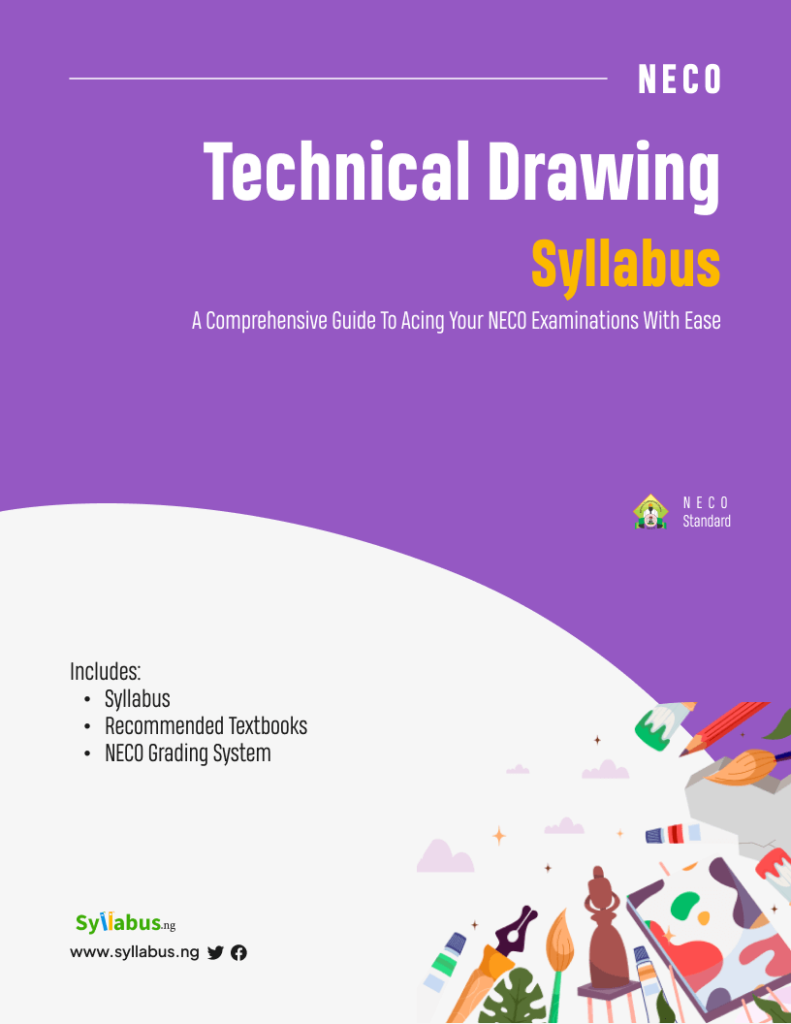Are you writing Technical Drawing in your NECO O’level exams? Download the recommended Technical Drawing syllabus to excel in your exams.

Home » NECO Syllabus » NECO Technical Drawing SyllabusThis NECO Technical Drawing exam syllabus is designed to guide you through everything you need to know to succeed in the exam. Technical drawing, sometimes called drafting, is all about visually communicating ideas, whether it’s for engineering, architecture, or design.
This syllabus covers the basics of drawing tools and techniques, along with more advanced topics like perspective, geometric constructions, and design principles. You’ll learn how to create clear, precise drawings that can be used to build, design, or explain projects.
This syllabus will also expose you to different types of technical drawings, like orthographic projections, isometric views, and exploded diagrams. Whether you’re interested in engineering, or architecture, or just love to draw and design, there’s something here for you.
Throughout the course, you’ll get to practice these skills through practical exercises and projects. By the end, you’ll not only be prepared for the exam but also equipped with skills that are valuable in many careers.
Let’s break down how the exam is structured and how the marking works. This should help you understand what to focus on and how to make the most of your time.
Paper 1: Multiple-Choice Objective
Paper 1 has 40 multiple-choice questions split into two sections. You’ll answer all 40 questions in one hour, totaling 40 marks. Paper 1 questions are divided into two part; Section A and B. Section A questions are 30 and they are set from general principles, techniques, and uses of plane and solid geometry. Section B has 10 questions and you are expected to choose between Part I (Building Drawing) and Part II (Mechanical Drawing). You are expected to answer all questions in your chosen part.
Paper 2: Essay Questions
Paper 2 comprises 5 essay questions, and you’ll need to answer 3 of them in 1 3⁄4 hours. The total marks for this paper are 60. This paper covers topics like plane geometry, solid geometry, and vector geometry. And each question carries 20 marks, answering three questions correctly can earn you a maximum of 60 marks.
Paper 3: Sketches and Practical Drawing
Paper 3 is the practical aspect of this exam, this paper has two sections, it requires a mix of sketches and detailed drawings. 2¾ hours will be allocated to this section for a total of 100 marks. This paper is divided into two sections; Section A and B.
Section A: This section contains three questions. One is compulsory, and you’ll need to answer one other question. This part focuses on sketches of objects, components, symbols, and tools used in the Building and Mechanical industries. You have 45 minutes to complete this section. The total questions required for your answer is worth 70 marks.
Section B: This section has two questions, one on Building Drawing and one on Mechanical Drawing. You’ll choose one to answer in 2 hours. The compulsory question in this section is worth 20 marks, while the other question is 10 marks.

Best candidates excel because they study smart and hard. Know what’s expected of you.
Download the NECO recommended Technical Drawing syllabus.
| TECHNICAL DRAWING | ||
| SN | TOPIC | OBJECTIVES |
| 1 | Drawing materials and equipment, types of drawing and applications | -Standard size drawing A2 ISO board and drawing sheet, set squares, drawing instruments, protractor and T-square. |
| 2 | Lines, lettering and dimensioning | -Types of lines and their uses. Types and styles of lettering, title blocks and border lines. These should conform to BS 1192 and BS 308A. |
| 3 | Division of lines and its applications | -Dividing into a given number of equal parts or proportion and other simple exercises involving mathematical problems. |
| 4 | Scales and their uses | -Plain and diagonal scales, constructions and their applications, including scale of chords. |
| 5 | Angles | Types and their constructions |
| 6 | Triangles, quadrilaterals and other polygons | Regular and irregular polygons: properties and their constructions. |
| 7 | Circles | Parts, types, properties and their constructions. |
| 8 | Tangents and tangency | Construction and application of principles of tangency to spanner, anchors and other tools. |
| 9 | Inscribed, circumscribed and inscribed figures | Definitions, identification and their constructions. |
| 10 | Similar figures and areas | Enlargement and reduction by area and side. |
| 11 | Loci | -Definition and construction of straight line, circle,ellipse, parabola, hyperbola, helix, trochoids (inferior and superior) spiral, cycloid, hypocycloid, involutes and link mechanisms. |
| SOLID GEOMETRY | ||
| 12 | Lines in space and planes | Location of points and lines in space. True length and angle of inclination of a line. Intersecting lines, plane relationships and traces. Types of planes and edge views of planes. |
| 13 | Pictorial drawing: isometric, oblique, perspective | Isometric scales and circles, oblique scales and curves. One and two points perspective, including free hand sketching. |
| 14 | Orthographic projection | Multiplane,1st and 3rd angle projection. |
| 15 | Auxiliary projections | Prisms, cones, cylinder, cube, pyramid (right and oblique), including second auxiliary projection. |
| 16 | Sectional views and true shapes | True shape of sections of prisms, cylinders pyramids and cones, (ellipse, parabola, hyperbola, circle and triangle). |
| 17 | Development of surfaces | Surfaces of right and oblique pyramids, prisms, cylinders, cones and their truncated parts and frustum .Transition pieces. |
| 18 | Intersection /Interpenetration | Intersections of cylinders, cones, prisms and pyramids. |
| SYMBOLS AND CONVENTIONS | ||
| 19 | Symbols and conventions used in plane and solid geometry | Example, the symbol used to indicate the diameter of a circle. |
| BUILDING DRAWING | ||
| 1 | Freehand sketching and identification of building tools | Both pictorial and orthographic sketches of building tools. |
| 2 | Foundations and Floors | Types and parts of foundations and floors. |
| 3 | Openings – windows, doors and arches | Types and parts of doors, windows and arches. |
| 4 | Stairs and staircases | Parts and types of staircases. |
| 5 | Roofs | Types and parts of roofs. |
| 6 | Constructional details of parts of buildings | Includes wall, column, beam, lintel, etc. |
| 7 | Working drawings of buildings | Orthographic projections and sectional views. |
| 8 | Building materials, freehand sketching, symbols and conventions | Including electrical and plumbing fittings. |
| MECHANICAL DRAWING | ||
| 1 | Freehand sketching and identification of mechanical tools | Both pictorial and orthographic sketches of mechanical tools. |
| 2 | Dimensioning | Limits and fits, allowances, tolerances; emphasis on correct techniques. |
| 3 | Screw threads, fasteners and locking devices | Include conventional representation, construction and their applications. |
| 4 | Sectioning | Full,half-part,offset,broken,removed,aligned and revolved. |
| 5 | Pictorial drawing | Isometric and oblique drawing; including freehand sketching. |
| 6 | Working and assembly drawing. | Orthographic and sectional views. |
| 7 | Symbols, conventions and abbreviations | Include electrical and plumbing fittings and welding symbols. |
1. M.A Parker and F. Pickup, Engineering Drawing with worked examples 1 & 2 (3rd edition). Nelson Thorns LTD
2. K. Morling, Geometric and Engineering.
3. A.Yarwood Geometric and Technical Drawing, ELB and Nelson.
4. A. Parkerson, Foundation of Technical Drawing.
5. W.E.Kudor, Technical Drawing with Mechanical Engineering & Drawing Option.
There are three papers: Papers 1, 2, and 3. Paper 1 and Paper 2 are taken together in one sitting, while Paper 3 is separate. To complete the exam, you must take all three papers.
Paper 1 has 40 multiple-choice questions, and you have one hour to answer them. It has two sections: Section A has 30 questions on plane and solid geometry, and Section B has 10 questions. For Section B, you can choose between Part I (Building Drawing) or Part II (Mechanical Drawing).
You have 1¾ hours to answer three out of five essay questions. The questions cover plane geometry, solid geometry, and vector geometry. This part is worth 60 marks, so take your time to explain your answers clearly and use diagrams when needed.
Paper 3 is in two sections and lasts 2¾ hours, with a total of 100 marks. Section A has three questions, one compulsory (worth 20 marks), and you choose one of the other two (worth 10 marks). This section focuses on sketches of objects, symbols, components, and tools from Building and Mechanical industries. Section B has two questions, one on Building Drawing and one on Mechanical Drawing, you choose one to answer in 2 hours, and it’s worth 70 marks.
Yes, you can bring basic drawing tools like pencils, erasers, rulers, compasses, and set squares. Check with your exam center for any specific rules they might have, but having these tools will help you create accurate and clear drawings.
Technical Drawing involves geometry, but it’s not heavily focused on complex math. As long as you understand basic geometric concepts and can apply them in your drawings, you should be fine. Just focus on practicing and getting familiar with the types of questions you’ll encounter.

Best candidates excel because they study smart and hard. Know what’s expected of you.
Download the NECO recommended Technical Drawing syllabus.